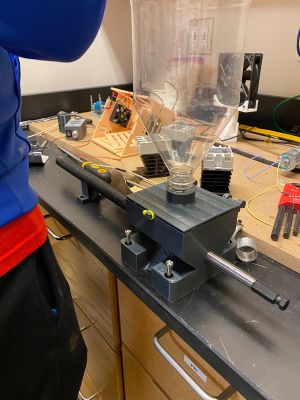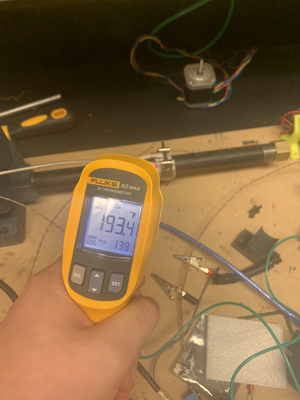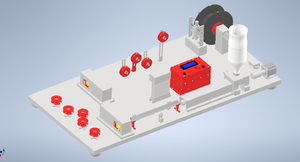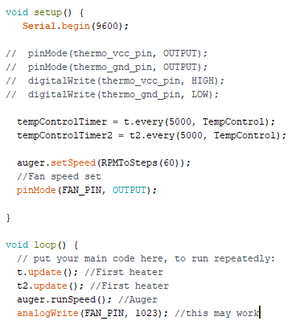Abstract
Approximately 30% of printed Polylactic acid (PLA) becomes scrap once printed because facilities don't have the means to recycle it [Insert Citation Here]. PLA, which is made primarily of corn starch, can decompose into CO2 and water if done correctly [1]. In order to recycle the printed PLA, students and faculty members must ship the PLA to a company in order for it to be melted and reused. The purpose behind this project is to design a Recycle bot in order to melt and spool printed PLA for easy accessibility for everyone. This was done by taking the schematics of a previous Recyclebot, analyzing what worked and what didn't work, and make updates and changes to accommodate for our material.
Objective
The goal of this project is to take failed 3D prints from previous and ongoing projects, and turn them into usable spools of filament for printing new parts. After the parts are crushed up, they are melted down and extruded in the Recyclebot and spun into new filament spools. The second version of the Industrial Recyclebot is to take the concept created in previous iterations of the project, and output filament at multiple times the current rate of the previous iterations. This revision focuses on outputting more filament, as well as making the entire project affordable and open source so that any end user could recreate and build the robot using a 3D printer, off the shelf parts at a local hardware store, and simple hand and power tools.
Background
The Open Source Hardware Enterprise focuses on designing projects that are easy to build in the average home and accessible to the public. We achieve this by considering cost-effectiveness and making sure that as many components as possible can be built in-house. Most of the time this means 3D printing parts from PLA since it is popular and well-supported among hobbyists everywhere. That being the case, the Enterprise has several 3D printers and consumes high amounts of PLA to build prototypes. Because of printer calibration, failed prints, and design revisions, around 30% of the PLA becomes scrap and is placed in a bin for recycling.
The Industrial Recyclebot was developed to reduce waste and save money by turning scrap plastic into full spindles of usable filament. It does this by melting pellets of ground-up plastic, extruding the molten material into a filament, and winding it onto a spindle for later use in 3D printing.
Problem/Opportunity Statement
The biggest issue of the original Industrial Recyclebot is the extrusion’s output efficiency. It takes approximately five hours to remelt down one pound of PLA. This is what we want to increase significantly. To increase extrusion, a stronger motor is required to continue to push the melted PLA. The auger that compresses the PLA must also be wider in order to reduce the amount of work on the motor. The final issue is a proper cooling system to avoid PLA sticking to itself as it is spun/rotated on the final spindle. The PLA will constantly be touching itself as it is spun to optimize the space on the spool. Automation is also desired, so a member does not have to watch the recycle bot run for the entire duration.
Currently, the enterprise has two different Recycle Bots. The first Recycle Bot is a test of concept, which has an extremely poor output of PLA. The Industrial Recyclebot has an improved system with an increased output of X5 the proof of concept. To fulfill these improvements, the original AC motor is going to be changed to a stepper motor, as the original AC motor speed cannot be controlled accurately. The next change to the Industrial Recyclebot addresses the premelting of the PLA in the piping around the auger bit. To do this, the length of the pipe and auger bit are going to be increased to discourage the heat from the heating elements to creep down the length of the pipe and into the hopper. Because of this change, the hopper design needs to be changed to account for the new pipe length. These new components will be 3D printed, much like the other parts on the robot. Figure 1 shows the Original Industrial Recyclebot layout that will be matched, but the components will need to be optimized. The current design utilizes multiplecontrol boxes to adjust the settings for the heaters.
With our new design, arduinos will be used to allow adjusting of the setting from a single display and a more user friendly interface. These arduinos will also allow the machine to run completely autonomous allowing the user to turn the machine on then guide the initial PLA strand and may leave the room. Many of the components being changed to allow for greater efficiency and reduce the overall cost of the robot by being found in more common sizes and materials, making them easier and cheaper to purchase.
Project Significance
Our project would significantly help the entire enterprise by reducing the cost of a product we use everyday. These reduced costs would also benefit the students who come to us to 3D print their designs. With a cheaper way to create prints, the cost reduction we can provide will help students save money. The university would also save money, as we have done 3D printing projects for them in the past. The enterprise has collaborated with recycling plants to spindle grinded plastic pieces in which the Recyclebot was able to respindle, and with the help of 75% recycled and 25% new plastic, the enterprise were the first ones able to accomplish this.
Bill of Material
All parts needed to build the Recyclebot Industrial: https://docs.google.com/spreadsheets/d/1--wpVHWRdGUFmkVhdwlE_zT6UvLu-SS9lYrpv1vjtVI/edit#gid=0
Tools Needed
Basic hand tools and basic power tools are all that is needed for this project. The Recyclebot Industrial can be put together using an assortment of metric allen keys, and a power drill with various sized drill bits. Every screw in this robot uses a hex key to screw the parts into place on the board, mainly socket head cap screws are used. The power drill is used to drill the exit hole for the filament at the end of the barrel, and to drill pilot holes for the screws in the board. No cutting is necessary for this project besides cutting the bottom off a 2 liter soda bottle.
Technical Specifications and Assembly Instructions
The technical specifications and assembly instructions can be found under the electrical and mechanical documentation folders in the OSHE google drive in the Recyclebot Industrial v2 project folder. These documents outline where everything is located in the shared drive, as well as the pinnout diagram for the Arduino and the assembly instructions to build the robot. Each part that needs to be printed can also be found in the shared drive under its parent assembly.
Recyclebot Industrial Link
Link to the Recyclebot Industrial v2 google drive folder: https://drive.google.com/drive/u/2/folders/13VQUPTlR__DdzswrnDUi_b33oggvaJiu
References
[1] T. Raine, “Reduce, reuse, recycle,” Printweek; London, pp. 31–32, 15-Mar-2007.
Fall 2019
Much of the Fall of 2019 was spent researching the proper specifications on how to effectively redesign the robot. This research included how to combine each control box into a single Arduino with a unique GUI interface, making the robot easier to control and allowing the user to save custom settings for future use. Other types of research included determining what the best size screw conveyor/ auger bit to use, as one of the goals for this project was to be able to create filament from any type of plastic. This meant that the auger size must increase in order for the robot to be able to process larger sized pellets such as PETG and PLA.
The second part of the Fall of 2019 semester was spent redesigning the hot end of the robot to accept the new auger size and drive motor. The drive motor that was previously used was a large DC motor that had little to no control, and switching to a stepper motor would allow us to control the rate at which the auger pushes the pellets. This, in turn, forced us to create a new hopper as the previous version used a specialty hopper designed for a specific screw conveyor. The redesign in the hopper also allows the user to 3D print the hopper instead of making cuts that are close to impossible to make without specialty equipment. This CAD work will be carried over into the Spring of 2020 where the goal is to have a completed and functioning robot so that testing can commence towards the extrusion of a final product.
Spring 2020
Spring of 2020 was focused on finalizing our first design and assembling it with the goal of having basic functionality by the end of the semester. Obviously the campus shutting down due to COVID-19 greatly affected our ability to accomplish that final goal but we still made good progress. As of the end of our ability to work in person, assembly of the entire hot end of the machine's mechanical and electrical elements was almost complete and we had begun verification testing of some basic functions. Our heaters were both able to turn on and we successfully regulated temperature using our Arduino code. For the stepper motors, we created test code and had started to test functionality when spring break started. Obviously we never got back into the lab to finish that verification work. Below is the current state of our build. Below is our current assembly(top) and our heaters running to a desired temp(bottom).


After things moved online our team shifted focus to preparing everything as much as we could so it could easily be picked up by the group next year. The mechanical design was finished in CAD for the entire cold end so we now have a finished design and CAD model for the entire system. On the software side we finished the code so that with minimal work next year verification testing of individual subsystems and whole system testing can resume quickly. The electrical system was documented in detail as well as the why parts were chosen and how they interact. All the parts that are needed to build the Industrial Recycle bot as currently designed as well as where to purchase those parts are laid out in our BOM document. Overall we are very happy with our design that we created and we undershot our expected price we had at the beginning of the year by quite a bit coming in with a cost to build of under $750. Below is the current CAD layout of our design.

For the next semester of this project the goal is a complete and functioning machine with a full UI and compatibility with multiple plastic types. Planning has already begun for the creation of a UI for easier user interaction with this system and all code has been designed so it can easily integrate with a UI. Below is our example code running the main loop set to begin testing.
